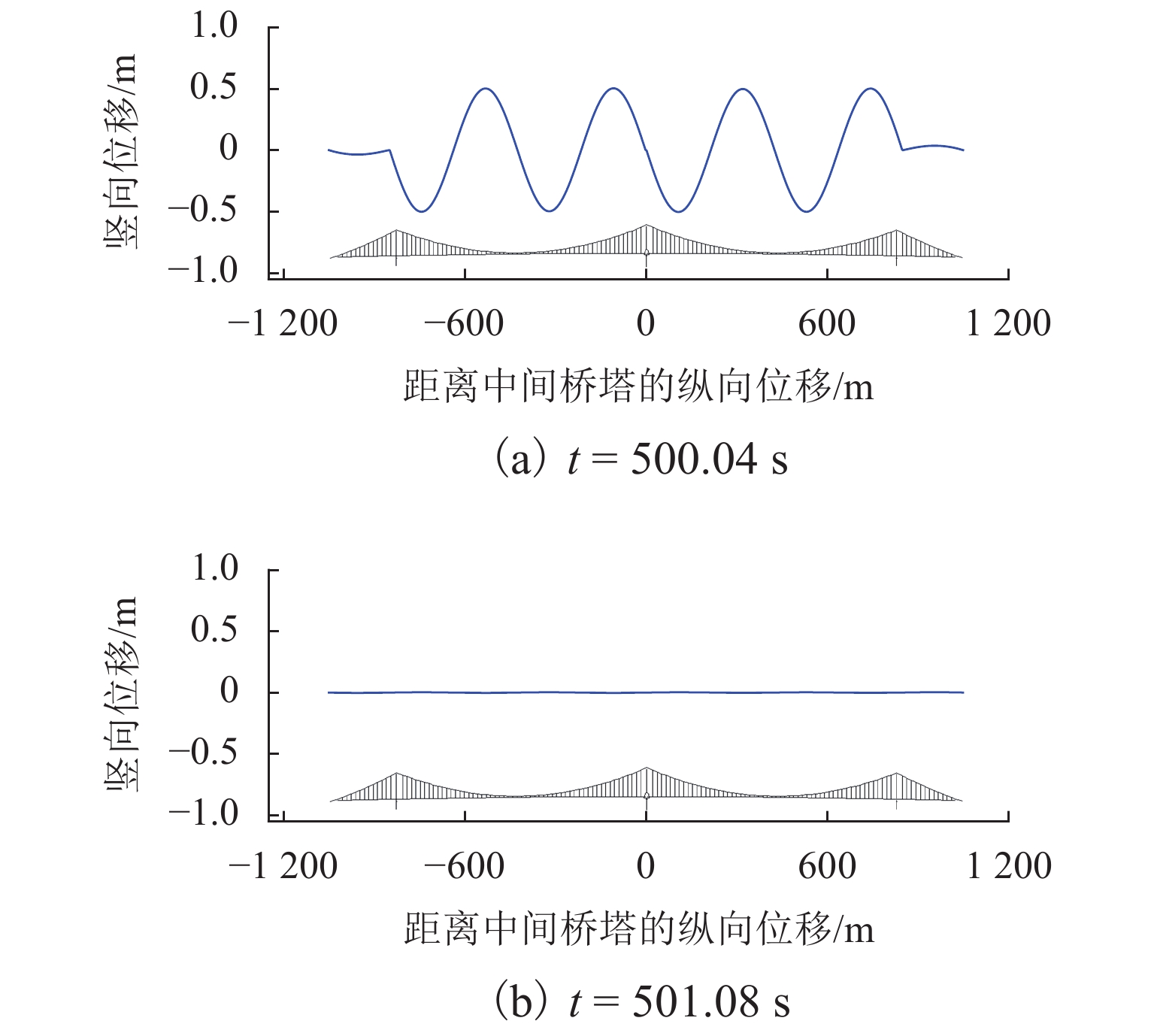Study on Driver’s Sight Line Under Vertical Vortex-Induced Vibration of Long Span Suspension Bridges
-
摘要:
为研究大跨度悬索桥竖弯涡振条件下桥上驾驶员的行车视线,首先,基于传统的风-车-桥耦合振动分析理论,引入桥梁涡激力数值模型,自主编制了涡振条件下风-车-桥耦合振动分析程序;其次,以有3个半波的涡振振型为例,借助几何作图法推导了桥面发生涡振时车内驾驶员视线盲区的计算公式;最后,基于已建立的涡振条件下风-车-桥耦合振动分析程序和驾驶员视线盲区的计算公式,以一座发生竖弯涡激共振的大跨度悬索桥为工程背景,分析了车型、车速和入桥时刻对车内驾驶员视觉盲区最大高度、盲区总持时和盲区占比的影响规律. 研究结果表明:驾驶员盲区最大高度呈现周期性变化,其周期约为车辆前进一个涡振半波长度所需要的时间;车速变化不会影响驾驶员盲区的最大高度,但车辆类型不同则驾驶员目高不同,车内驾驶员目高越低,驾驶员前方视觉盲区最大高度也就越高;车重会进一步增加驾驶员前方视觉盲区的最大高度;车辆入桥时刻对驾驶员盲区总持时的影响很小,但驾驶员盲区总持时随着车速的提高而降低;车辆入桥时刻或车速对驾驶员盲区占比的影响小,而车型则对驾驶员盲区占比的影响显著,其中小轿车驾驶员的盲区占比最高(21%左右),大客车驾驶员的盲区占比最小(12%左右).
Abstract:In order to study the driver’s sight line under vertical vortex-induced vibration (VVIV) of long span suspension bridges, a numerical framework of coupled wind-vehicle-bridge system considering VVIV (termed as WVB-VIWW) is proposed by introducing a vortex aerodynamic model into the traditional coupled WVB theory. Based on the proposed framework and with the aid of geometric construction method, the equation of driver’s blind region under VIVV is derived based on a vortex vibration mode with three half-sine-waves. Subsequently, the proposed WVB-VIVV framework and equation of driver’s blind region are applied to a long span suspension bridge which has experienced VVIV. The influence of several key factors, i.e., vehicle type, vehicle speed, and the time instant where vehicle enters the bridge, on the maximum height of driver’s blind region, the total time duration of the driver’s blind region, and the ratio of driver’s blind region is investigated. The results indicate that the maximum height of the driver’s blind region varies periodically, and the period is approximately equal to the time required by the vehicle to travel through a half-sine-wave. The vehicle speed has an insignificant effect on the maximum height of driver’s blind region. Because the driver’s sight line height varies with the vehicle type, the lower the driver’s sight line height, the higher the maximum height of the driver’s blind region. Additionally, the vehicle weight could increase the maximum height of the driver’s blind region by increasing the overall deflection of the bridge span. It is also found that the total time duration of driver’s blind region is insensitive to the time instant where vehicle enters the bridge, but the total time duration of driver’s blind region decreases with the increase of the vehicle speed. Furthermore, the time instant where the vehicle enters or the vehicle speed has barely no effect on the ratio of driver’s blind region. However, the vehicle type has remarkable influence on the ratio of driver’s blind region, e.g., the ratio of driver’s blind region for sedan car and megabus is approximately 21% and 12%, respectively.
-
随着世界经济和交通的快速发展,桥梁的跨越能力不断提升,同时,桥梁也愈发轻柔,对风的作用愈发敏感. 现有工程实践证明,大跨度桥梁的颤振问题在桥梁抗风设计阶段通过提高颤振临界风速已得到解决,而涡振却仍然没有得到很好的解决[1-4]. 例如日本的东京湾通道桥(Trans-Tokyo Bay Bridge)、丹麦的大带东桥(Great Belt East Bridge)、英国的塞文二桥(Second Severn Bridge)、巴西里约尼泰罗伊大桥(Rio-Niteroi Bridge)等世界知名大桥均发生过大幅涡激振动现象[5]. 2020年4月26日—5月18日,我国的武汉鹦鹉洲长江大桥、浙江舟山西堠门跨海大桥、广东虎门大桥接连突发大幅涡激振动,引发社会强烈关注.
尽管涡振不会像颤振一样对结构产生毁灭性破坏,但涡振过大的振幅会影响桥上行车的安全性和舒适性,影响桥梁的正常运营. 此外,由于涡振发生的风速为常遇风速,频繁发生的涡振还有可能导致桥梁构件的疲劳破坏. 在涡振对桥梁构件疲劳性能影响方面:Hosomi等[1]将自然风的特性和桥梁空气动力学特性结合在一起,提出了一种数值随机方法来研究涡振对桥梁疲劳强度的影响;祝自强[6]基于某钢拱桥吊杆的风致疲劳破坏和风洞试验,开展了大长细比H型开孔腹板吊杆的疲劳研究;Xu等[7]发现,调谐质量阻尼器能明显降低桥面的涡振响应,从而降低了涡振对桥梁疲劳寿命和使用性能的影响. 在涡振对行车安全性和舒适性的影响研究方面:Cao等[8]指出涡激振动会严重影响交通的舒适性和安全性,并建议在涡振初期应采取合理的控制措施,以确保过往车辆的安全;陈政清等[5]讨论了考虑人体舒适性和行车安全的大跨度桥梁竖弯涡振限值.
此外,桥梁发生涡振时,桥面会形成凹凸起伏的曲线有可能会对驾驶人的行车视线造成干扰,造成驾驶员心理恐惧从而影响到驾驶员的行车安全. Larsen等[2]在研究丹麦大带东桥的涡振时发现,主梁涡振振幅过大会对驾驶员视线造成一定的遮挡,可能会使驾驶人分心,还会对行车安全造成潜在威胁. 陈政清等[5]在研究桥梁涡振对行车安全的影响时,通过计算驾驶员的视觉盲区,确定了桥梁的涡振限值. 随后,陈尚烽[9]建立了考虑行车安全性的涡振限值计算模型,并与规范采用的方法及其限值进行了比较. Cao等[8]采用简谐波模拟大跨度悬索桥桥面的涡振形态,并通过假定障碍物高度来计算桥梁涡振限值. 《公路工程技术标准》(JTG B01—2003)[10]根据停车视距的要求规定了不同设计车速下竖曲线应满足的最小半径和最小长度,但并未对驾驶员视觉盲区进行相关限制.
综上所述,当桥梁发生涡振时,为了能确保桥梁结构本身和桥上行车的安全,需要确定合理的涡振控制指标. 目前,国内外规范或相关研究都是从涡振限值(人体振动舒适性)、行车视线(行车安全)以及涡振引起结构构件的疲劳等角度来提出桥梁涡振性能的评价指标. 通过调研已有的涡振条件下行车安全性和舒适性评价的文献可知,目前还未见文献针对桥梁涡振条件下驾驶员视线展开专门的研究.
本文基于自主编制的涡振条件下风-车-桥耦合振动分析程序,从行车视线的角度出发,研究了大跨度悬索桥竖弯涡振条件下驾驶员行车视线的影响因素. 本文的主要创新点在于将涡激力数值模型引入风-车-桥耦合振动分析理论,并推导了桥面发生涡振时车内驾驶员视线盲区的计算公式,从而实现桥梁涡振条件下车辆过桥时驾驶员行车视线及影响因素的研究. 本文以武汉鹦鹉洲长江大桥为工程背景,研究了车辆在发生涡振的桥面上行驶过程中驾驶员行车视线的特点和影响因素,探讨了不同车型、不同车速以及不同入桥时刻对驾驶员视觉盲区最大高度和盲区持续时间的影响. 本文的研究成果对于大跨度桥梁的竖弯涡振性能评估和涡振控制指标的确定具有一定的指导意义.
1. 工程背景
鹦鹉洲长江大桥为三塔四跨钢-混结合加劲梁悬索桥,矢跨比为1∶9,跨度布置为200 m + 2 × 850 m + 200 m,如图1所示. 主梁采用双铰式支承体系,中塔为钢-混凝土叠合结构,边塔为混凝土结构. 中塔下横梁及两边塔下横梁上设有主梁竖向支座和横向抗风支座,同时,在两边塔下横梁上设有纵向液压阻尼装置. 索塔总高152 m,两根主缆横向间距为36 m.
2020年4月26日12:00—13:00及16:00—17:30两个时段内,鹦鹉洲长江大桥主梁发生风致振动. 通过分析监测系统记录的数据显示:1) 振动以竖弯为主,扭转成分很小,且主梁振动频率单一,主频为0.244 Hz. 通过分析沿主梁布置的多个挠度测点数据以及分析监测视频判断,主振型为四阶竖向反对称弯曲振型,与桥梁第12阶振型相同. 桥梁第12阶振型的频率为0.242 Hz,振型如图2所示. 2) 振动稳定后,汉阳侧主跨和武昌侧主跨的1/8、3/8、5/8、7/8点的竖向位移振幅基本一致,为0.50 m. 3) 振动发生时段平均风速长时间稳定在7.0~7.6 m/s,且风向基本垂直于桥梁轴线(约为80°). 4) 振动发生时段湍流度低,在5.86%~7.66%. 综合上述分析推断本次振动类型为风致涡激共振(竖弯).
2. 涡振条件下风-车-桥耦合振动分析框架
为了研究大桥主梁涡振条件下驾驶员的行车视线,通过在传统的风-车-桥运动方程中引入主梁涡激力模型,建立了涡振条件下风-车-桥运动方程[11-14],如式(1)、(2).
Mb¨ub+Cb˙ub+Kbub=Fwb+Fvb, (1) Mv¨uv+Cv˙uv+Kvuv=Fwv+Fbv, (2) 式中:M、C、K分别为质量矩阵、阻尼矩阵和刚度矩阵;
¨u 、˙u 、u分别为加速度、速度和位移向量,下标b表示桥梁子系统,下标v表示车辆子系统,下标w表示风荷载;Fvb、Fbv为车-桥系统间的相互作用力,大小相等,但方向相反; Fwv为作用在车辆上的风荷载;Fwb为关于主梁涡激力的函数.本文采用分离迭代方法求解风-车-桥耦合振动方程,即用分离迭代法在每一积分步分别独立求解式(1)和式(2),再根据两个子系统间的耦合关系进行平衡迭代.
目前,风-车-桥耦合振动的理论和实践均得到了长足发展,已较为完备. 因此,式(1)和(2)中的车-桥系统间的相互作用力(Fvb和Fbv)和作用在车辆上的风荷载(Fwv)的计算方法以及风-车-桥运动方程具体的求解流程本文不再赘述,可参考文献[15]做进一步了解. 在此,本文仅介绍式(2)中与主梁涡激力相关的函数Fwb的模拟.
针对主梁涡激力的研究,许多学者开展了大量的研究工作,提出了很多理论和方法. 迄今为止,关于涡激力的理论模型已有数十种,如简谐力模型、升力振子模型、经验线性模型等,但是仍然没有一个模型能够全面地解释涡激共振现象[16]. 这是由于涡激振动十分复杂,尾流的漩涡脱落在涡振锁定区间的上升段、下降段等不同的振动阶段以及结构的不同边界条件下会呈现出多种不同的模态. 伴随着尾流涡模态的转变,流体作用力的大小以及流体作用力与结构响应之间的相位差等都会相应变化. 因此,用一个统一的数学模型来描述涡激力十分困难. 可以确定的是,对于等幅稳定的涡激工作,气动力的输入是简谐稳定的. 本文采用最简单的简谐涡激力模型,即假设主梁发生第n阶模态的涡激共振,Fwb可表示为
Fwb=∫L0φn(x)P(t)dx, (3) 式中:φn(x)为主梁第n阶模态振型;L为主梁展向全长;P(t)为简谐涡激力,如式(4).
P(t)=12ρU2D˜CLsin(ωnt+θ)=asin(ωnt+θ), (4) 式中:ρ为空气密度;U为来流速度;D为主梁横风向尺寸;
˜CL 为气动升力系数,与主梁外形有关,是斯托罗哈数St的函数;ωn为主梁第n阶固有频率;θ为相位角;a为系数.由式(4)可知,为了能预测大跨桥梁多阶涡振的风速区间和涡振振幅,通常需要开展风洞实验或数值模拟来确定主梁的相关气动系数(对于其他涡激力模型,也同样如此)[16]. 在本研究中,由于已知大桥发生涡振时的频率和振幅,因此可通过反算的方式来求得式(4)中的系数a为
a = A1A0, (5) 式中:A1=0.50 m为实测的主梁竖向位移振幅;A0为通过数值计算得到的单位涡激力作用下主梁的竖向位移振幅.
A0的具体计算如下:首先,令a=1.0,ωn=2πf= 1.521 rad/s为主梁第12阶自振频率,相位角θ=0,将上述参数代入式(4)计算单位涡激力;其次,将单位涡激力代入式(3)和式(1),进行单位涡激力作用下桥梁的动力响应分析,由此得到桥梁振动稳定后主梁的竖向位移振幅A0. 通过上述计算,a=51020.4,此时桥梁每个主跨的1/8、3/8、5/8和7/8点的幅值(波峰或波谷距离平衡位置)均为0.50 m.
由于篇幅限制,图3仅给出了汉阳侧主跨3/8点(振幅最大点)和跨中(驻点)处竖向位移时程. 由图3可知:当主梁振动趋于稳定后,3/8点处的振幅为0.500 m;跨中的幅值为0.005 m. 此外,图4还给出了全桥主梁在相隔1/4个周期(0.25T≈1.03 s)的2个典型时刻的竖向位移. 由图4可知:在车辆行驶时间t=500.04 s,主梁的竖向位移幅值达到最大; t=501.08 s,整个主梁的竖向位移为0.
由图3和图4可知,本节提出的方法可以很好地实现武汉鹦鹉洲长江大桥在2020年4月26日发生的涡振. 将在此基础上进一步开展鹦鹉洲长江大桥发生涡振时桥上驾驶员视线的研究. 需要说明的是,本文所提出的简谐涡激力模型需要事先已知主梁(比如本文的算例鹦鹉洲大桥)发生涡振时对应的模态、振幅和风速等信息. 当上述信息无法预知时,一般应通过节段模型风洞实验或数值模拟(如CFD)确定. 即便如此,受限于现有的风洞实验和数值模拟技术,准确预测实桥发生涡振时的模态、振幅和风速仍然是一个较为困难的问题.
3. 驾驶员视线盲区计算
3.1 驾驶员视线盲区特征分析
图5为大带东桥[2]发生涡振时摄像机在同一地点不同时刻拍摄的2张照片,圈内车辆为停车状态. 由图5可以看到,摄像机前方桥面处于波峰时圈中车辆被遮挡了一部分,而当摄像机前方桥面振动回到波谷时圈中车辆又恢复了正常. 由此可以预见,当车辆行驶前方桥面处于涡振波峰位置时,驾驶员的视线将会受到遮挡.
主梁发生竖向涡振时,桥面沿桥轴线也做周期性竖向振动(振型曲线参见图2). 如无特殊说明,下文的涡振均指竖向涡振. 由于涡振振型是数个波峰与波谷的组合,当车辆在发生竖向涡振的桥面上行驶(或驻停)时,车内驾驶员对前方邻近波谷的视线最容易受到前方波峰的遮挡. 若车辆正好处于桥面波谷位置时,车内驾驶员的行车视线最为不利. 为了简化计算,本文取包含3个半波的涡振振型区间为例,建立了考虑风-车-桥的耦合振动的行车视线计算模型,如图6所示. 图中:A2为车辆当前时刻所处桥上的位置;A1为驾驶人双目的位置;h1为驾驶员目高;h2为障碍物高度;h3为视觉盲区内障碍物的最大高度;ha为当前时刻涡振振幅; L1为相邻2个驻点之间的间距;∆l为一个时间步 ∆t 内车辆沿桥轴向所走的路程;hq为考虑了风-车-桥的耦合振动后,该时刻桥梁主梁相对于平衡位置的位移(平衡位置以上为正,以下为负);∆hq为一个时间步 ∆t 内车轮与桥面接触点的竖向位移,驾驶员实际目高与换算目高之差∆h=A1A3. 图6中,通过引入一条切线A5P,使得A5P//A1Q,同时过点P做铅垂线交A1B1于B3点. 若障碍物位于切点P,且高度小于PB3,则该时刻驾驶员将无法观察到该障碍物,此时的PB3为驾驶员盲区最大高度.
为了分析车辆在桥上行驶过程中车内驾驶员的视觉盲区,可以分为以下4种情况:车辆驶向波谷(一区域)、车辆驶离波谷(二区域)、车辆驶向波峰(三区域)以及车辆驶离波峰(四区域),如图6所示. 当车辆位于四区域时,由于前方的盲区超过了计算所取的3个半波(即驾驶员视觉盲区距离车辆位置较远),可认为该区域车辆驾驶员不存在盲区;而当车辆位于一区域、二区域和三区域时,在车辆前进方向邻近波谷区域均有可能存在视觉盲区,且视觉盲区内障碍物的最大高度可达h3. 因此,为了方便计算盲区最大高度,假定位于B2点存在高度为h2的障碍物.
假定桥梁的振型为简谐波形式,且相邻2个驻点之间的间距为L1. 由∆C1B1C3和∆A3C1A4的相似关系可得
¯C3B1¯C1C3=¯A4C1¯A3A4, (6) 式中:对于一区域和二区域,
¯C3B1=L1/2 ,¯A4C1 =L1−vΔt,¯C1C3 =ha− h2,¯A3A4 =h1−ha−Δh + hq;对于三区域,¯C3B1 =L1/2,¯A4C1 = L1/2−vΔt,¯C1C3=ha−h2 ,¯A3A4 =h1−ha-Δh + hq;v为车辆行驶速度.代入式(6)可得各区域障碍物高度为
h2={ha−(h1+hq−ha−Δh)L13L1−2vt,一、二区域,ha−(h1+hq−ha−Δh)L1L1−2vt,三区域. (7) 如果取
Δh=0 ,则可以得到h2的估算值h2g,即h2g={ha−(h1+hq−ha)L13L1−2vt,一、二区域,ha−(h1+hq−ha)L1L1−2vt,三区域. (8) 由几何关系可以得到h3=2h2,因此,可得h3g=2h2g. 同时,由于h3g 总大于估算值h3,所以可以把h3g 看作是h3的一个下限值.
需要说明的是,当涡振振型存在3个以上的半波时,更远处的波峰也会对驾驶人更远处的视线造成遮挡. 考虑到在行车过程中驾驶员总是最关注前方离自己较近的路况,因此仅取车辆所处位置附近3个半波长为计算区域. 当主梁的涡振振型少于3个半波时,驾驶员视觉盲区高度计算方法类似于三区域. 其中,当主梁振型为单半跨(一阶对称竖弯)时,驾驶员的视觉盲区高度最大值的位置正好位于桥梁主梁另一端,即h3g=h2g.
3.2 驾驶员盲区最大高度工况设置
1) 车型与车速:考虑了4种车型,分别为小轿车、普通厢式货车、大客车和大型集装箱车. 表1给出了这4种车型与驾驶员视线有关的参数[15]. 表中:hv为车辆质心高度;hc为车辆质心与驾驶员座椅之间的高差;hs为正常成年男子端坐时视线与座椅的距离,约为0.60~0.70 m,本文取0.65 m. 由此可计算出4种车型的驾驶员目高h1分别为1.07、1.45、1.60 m和1.60 m. 此外,所有车型均考虑6种车速,即30、40、50、60、70、80 km/h.
表 1 与驾驶员视线相关的参数取值Table 1. Parameters related to driver’s line of sightm 车型 hv hc hs h1 小轿车 0.72 0.3 0.65 1.07 普通厢式货车 1.50 0.7 0.65 1.45 大客车 1.35 0.4 0.65 1.6 大型集装箱车 1.35 0.4 0.65 1.6 2) 车辆入桥时刻:所有车型行驶的过程均为道路—桥梁—道路,如图7所示. 由于结构的对称性,选取车辆行驶至大桥汉阳侧主跨的1/8、3/8、5/8、7/8处的波谷位置(工况1~4)作为最不利工况,即车辆分别行驶至大桥汉阳侧主跨的1/8、3/8、5/8、7/8处时,该桥面正好位于波谷位置. 表2给出了这4种工况下,不同车速对应的入桥前道路长度Lroad以及车辆行驶至相应主跨八分点波谷时的时刻.
表 2 行车视线工况设置Table 2. Case settings on studying diver’s sight line车速/(km·h−1) 工况 1 工况 2 工况 3 工况 4 Lroad /m t /s Lroad /m t/s Lroad /m t/s Lroad /m t /s 30 213.34 62.44 224.34 89.32 203.66 112.04 214.32 138.88 40 203.22 45.92 243.12 68.68 193.56 83.12 233.00 105.84 50 216.34 37.68 204.46 52.16 195.00 66.60 240.34 85.20 60 251.68 33.52 211.34 43.88 242.66 58.36 201.66 68.68 70 264.66 29.40 252.34 39.72 243.78 50.08 231.44 60.40 80 254.78 25.28 271.12 35.60 198.88 41.80 215.22 52.12 4. 驾驶员盲区最大高度和盲区持时影响因素
4.1 典型车辆过桥时的动力响应
本节以小轿车单车过桥为例,给出了小轿车分别以30、50、70 km/h过桥时车辆质心的竖向位移时程,如图8所示. 根据国际标准ISO 8608[17],路面粗糙度类别一共可以分为非常好(A级)到非常差(H级)8种. 虽然路面粗糙度对车-桥耦合振动的影响较大,但考虑到本文主要研究驾驶员的行车视线,路面粗糙度对其影响非常小,因此所有工况中的路面粗糙度等级均设置为非常好(A级),如图9所示. 此外,考虑到鹦鹉洲大桥发生涡振时的平均风速在7.0~ 7.6 m/s,本文所有工况中车辆受到的风速取为7.3 m/s.
由图8可知:在风荷载、桥梁周期性的竖向涡振以及路面不平度的激励下,车辆在桥梁上行驶时的竖向振动具有显著的周期性特点,且竖向位移幅值为0.5 m,与桥梁涡振时的竖向振动幅值相同;尽管不同车速下车辆质心的竖向位移幅值相同,但竖向位移变化的周期有显著区别. 由于本文考虑的是主梁四阶竖向反对称弯曲振型(见图2),因此每当车辆行驶至每一跨主梁的八分点(主梁1/8、3/8、5/8和7/8点)时,车辆都会经历周期性的竖向振动. 当车速较慢时,车辆能更加充分地“感受”到主梁八分点传递来的竖向振动,此时车辆的周期性竖向振动就较为显著. 与此相反,当车速较快时,车辆能较快地经过桥梁八分点,虽然也会经历周期性振动,但并不显著.
4.2 车型对驾驶员盲区最大高度的影响
本节讨论了不同车型对驾驶员盲区最大高度的影响. 限于篇幅,所有类型车辆的车速均为30 km/h. 图10(a)~(d)分别为4种车型和4种不同工况下,车辆在桥上行驶过程中车内驾驶员视觉盲区最大高度的变化,其中图内的数字为最大高度. 由图可知:当桥面发生涡振时,车辆在桥上行驶过程中前方桥面的周期性起伏运动会导致车内驾驶员出现周期性的视觉盲区;当车辆位于主梁1/8、3/8、5/8和7/8跨及其附近时,驾驶员视觉盲区的最大高度达到最大值;而当车辆位于主梁2/8、4/8和5/8跨及其附近时,驾驶员视觉盲区的最大高度最小或盲区消失. 这是由于桥面发生涡振时,主梁1/8、3/8、5/8和7/8跨的最大振幅可达0.5 m,而主梁2/8、4/8和5/8跨为驻点,振幅始终接近于0.
另外,不同车型的车内驾驶员视觉盲区最大高度也不相同. 在4种工况下,小轿车、普通厢式货车、大客车和大型集装箱车的车内驾驶员视觉盲区的最大高度分别为0.9484 m(工况2)、0.6088 m(工况1)、0.4861 m(工况1)和0.5648 m(工况2). 由此可知,小轿车驾驶员视觉盲区的最大高度最大,而大客车驾驶员视觉盲区的最大高度最小. 不同车型车内驾驶员视觉盲区最大高度之间的差异主要与驾驶员目高和车重(风-车-桥耦合作用)有关:对于小轿车,其车内驾驶员目高在4种车型中是最低的(1.07 m),因此小轿车驾驶员视觉盲区高度最高;大客车和大型集装箱车的驾驶员目高最高且均为1.60 m,因此,大客车和大型集装箱车的驾驶员盲区最大高度要比其余两种车型低. 进一步对比大客车和大型集装箱车驾驶员最大盲区高度发现:大型集装箱车驾驶员最大盲区高度(0.5648 m)比大客车驾驶员最大盲区高度(0.4861 m)要高出16.1%. 这是由于风-车-桥耦合作用引起的:大型集装箱车车重要远大于大客车车重,考虑风-车-桥耦合作用后,大型集装箱车引起主梁的整体下挠要大于大客车引起主梁的整体下挠,将导致大型集装箱车的hq比大客车的大. 由式(9)和式(10)可知:当车辆位于波谷附近时,hq为负值,其绝对值越大,视觉盲区高度h3g也越大,因此大型集装箱车驾驶员前方视觉盲区最大高度比大客车大.
由此可见:驾驶员目高越低,驾驶员前方视觉盲区最大高度也就越高. 由于风-车-桥耦合作用带来的主梁整体下挠会进一步增加驾驶员前方视觉盲区最大高度,具体表现为:车重越大,主梁整体下挠越明显,视觉盲区最大高度增加越大. 因此,4种车型中,桥面发生涡振时,小轿车驾驶员的行车视线最差,大客车驾驶员的行车视线最好.
4.3 车速对驾驶员盲区最大高度的影响
本节以小轿车为例,讨论了不同车速对驾驶员盲区最大高度的影响. 不同车速下小轿车入桥前的道路长度参考表2中工况2的取值. 图11(a)~(f)给出了桥梁涡振条件下,小轿车以不同车速在桥上行驶过程中,车内驾驶员视觉盲区最大高度随车辆沿桥纵向位置的变化规律. 由图11可知:不同车速下,小轿车盲区最大高度非常接近(1.1%以内),因此可以认为车速对驾驶员盲区最大高度的影响很小. 尽管如此,车速对盲区最大高度的变化周期却有显著的影响. 从图11可以看出:车辆在桥上行驶过程中,车内驾驶员盲区最大高度呈周期性变化,其周期约为车辆前进一个涡振半波(即1/4个主跨)的长度所需要的时间,即tm≈0.25L1/v,其中,L1=850 m为主跨的长度. 由此可以推算出:当车速为30、40、50、60、70、80 km/h时,小轿车驾驶员盲区最大高度的变化周期分别约为25.51、19.13、15.30、12.75、10.93、9.56 s.
4.4 车型和车速对驾驶员盲区总持时的影响规律
车辆类型主要影响视觉盲区的最大高度,而车速主要影响视觉盲区的变化周期. 无论是出现周期性盲区还是持续性盲区,盲区总的持续时间均会影响驾驶员的心理状态,并影响行车的安全性. 因此,本节将详细研究4种工况下,不同车辆类型和车速对车辆在桥上行驶过程中车内驾驶员经历盲区总持时的影响规律. 图12给出了4种工况下,不同类型车辆以车速30 km/h在桥上行驶过程中车内驾驶员经历的盲区总持时. 由图可知:小轿车驾驶员经历的盲区总持时最长,为43.44 s;大客车驾驶员经历的盲区总持时最短,仅为24.52 s,是小轿车的56.45%;普通厢式货车和大型集装箱车驾驶员的盲区总持时分别为29.52 s和27.16 s. 此外,对于同一种车型,驾驶员的盲区总持时在4种工况中基本保持不变,即驾驶员的盲区总持时不随车辆入桥时刻的变化而变化.
为了进一步研究车速对驾驶员在桥上经历盲区总持时的影响,图13给出了小轿车驾驶员盲区总持时随车速变化的直方图. 由图可知,小轿车驾驶员盲区总持时随着车速的提高而降低,但降低的速率随车速的提高而放缓. 例如,当车速从30 km/h提高至40 km/h时,驾驶员盲区总持时从43.44 s下降23.94%至33.04 s,而当车速从70 km/h提高至80 km/h时,驾驶员盲区总持时从18.82 s下降13.71%至16.24 s.
4.5 车型和车速对驾驶员盲区占比的影响
驾驶员盲区占比是指车辆在桥上行驶过程中,驾驶员盲区总持时占车辆在桥上行驶总时长的比重. 盲区占比过大也会引起驾驶员的恐惧和不适,容易造成安全隐患. 图14给出了车速30 km/h时,4种工况下不同车型驾驶员的盲区占比. 由图可知:小轿车驾驶员的盲区占比最大,为21.27%;大客车驾驶员的盲区占比最小,仅为12.01%;普通厢式货车和大型集装箱车驾驶员的盲区占比分别为14.46%和13.30%. 此外,对于同一种车型,各工况的驾驶员盲区占比基本不变,即驾驶员的盲区占比不随车辆入桥时刻的变化而变化.
以小轿车为例,进一步研究车速对驾驶员盲区占比的影响,如图15所示. 由图可知:不同车速下,小轿车驾驶员盲区占比差异很小,保持在21%左右,表明车速对同一种车型驾驶员盲区占比的影响较小,与车速对盲区总持时的影响规律不同. 这是因为,虽然驾驶员盲区总持时随着车速的提高而变短,但车辆在桥上行驶的总时长也随着车速的提高而变短. 例如:当车速为30 km/h时,车辆在桥上行驶总时长为204.16 s,驾驶员盲区总持时为43.32 s,此时盲区占比为21.22%;当车速为80 km/h时,车辆在桥上行驶总时长为76.52 s,驾驶员盲区总持时为16.58 s,此时的盲区占比为21.67%. 因此,对于同一种车型,不同车速下的驾驶员盲区占比基本保持不变.
5. 结 论
本文基于自主编制的涡振条件下风-车-桥耦合振动分析程序,以一座发生竖向涡振的桥梁为工程背景,研究了车型、车速和入桥时刻对车内驾驶员视觉盲区最大高度、盲区总持时和盲区占比的影响规律,结果表明:
1) 车型会影响驾驶员盲区最大高度. 首先,不同车型的驾驶员目高不同. 其次,由于风-车-桥耦合作用带来的主梁整体下挠还会进一步增加驾驶员前方视觉盲区最大高度. 因此,当桥面发生竖向涡振时,小轿车驾驶员的行车视线最差(即驾驶员出现视觉盲区概率最高),大客车驾驶员的行车视线最好(即驾驶员出现视觉盲区概率最低).
2) 车辆在桥上行驶的过程中,车内驾驶员盲区最大高度呈现周期性变化,其周期约为车辆前进一个涡振半波长度所需要的时间. 车速的变化不会影响驾驶员盲区的最大高度,但车速越快,盲区最大高度的变化周期越短.
3) 车辆入桥时刻对驾驶员盲区总持时的影响很小,但驾驶员盲区总持时随着车速的提高而降低. 此外,相同车速下,小轿车驾驶员的盲区总持时最长,大客车驾驶员的盲区总持时最短. 车辆入桥时刻或车速对驾驶员盲区占比的影响很小. 但车型对驾驶员盲区占比的影响显著,其中小轿车驾驶员的盲区占比最高(21%左右),大客车驾驶员的盲区占比最小(12%左右).
-
表 1 与驾驶员视线相关的参数取值
Table 1. Parameters related to driver’s line of sight
m 车型 hv hc hs h1 小轿车 0.72 0.3 0.65 1.07 普通厢式货车 1.50 0.7 0.65 1.45 大客车 1.35 0.4 0.65 1.6 大型集装箱车 1.35 0.4 0.65 1.6 表 2 行车视线工况设置
Table 2. Case settings on studying diver’s sight line
车速/(km·h−1) 工况 1 工况 2 工况 3 工况 4 Lroad /m t /s Lroad /m t/s Lroad /m t/s Lroad /m t /s 30 213.34 62.44 224.34 89.32 203.66 112.04 214.32 138.88 40 203.22 45.92 243.12 68.68 193.56 83.12 233.00 105.84 50 216.34 37.68 204.46 52.16 195.00 66.60 240.34 85.20 60 251.68 33.52 211.34 43.88 242.66 58.36 201.66 68.68 70 264.66 29.40 252.34 39.72 243.78 50.08 231.44 60.40 80 254.78 25.28 271.12 35.60 198.88 41.80 215.22 52.12 -
[1] HOSOMI M, KOBAYASHI H, NITTA Y. Fatigue strength design for vortex-induced oscillation and buffeting of a bridge[J]. Journal of Wind Engineering and Industrial Aerodynamics, 1997, 67(4): 227-237. [2] LARSEN A, ESDAHL S, ANDERSEN J E, et al. Storebælt suspension bridge-vortex shedding excitation and mitigation by guide vanes[J]. Journal of Wind Engineering and Industrial Aerodynamics, 2000, 88(2/3): 283-296. doi: 10.1016/S0167-6105(00)00054-4 [3] FRANDSEN J B. Simultaneous pressures and accelerations measured full-scale on the Great Belt East suspension bridge[J]. Journal of Wind Engineering and Industrial Aerodynamics, 2001, 89(1): 95-129. doi: 10.1016/S0167-6105(00)00059-3 [4] FUJINO Y, YOSHIDA Y. Wind-induced vibration and control of trans-Tokyo bay crossing bridge[J]. Journal of Structural Engineering, 2002, 128(8): 1012-1025. doi: 10.1061/(ASCE)0733-9445(2002)128:8(1012) [5] 陈政清,黄智文. 大跨度桥梁竖弯涡振限值的主要影响因素分析[J]. 中国公路学报,2015,28(9): 30-37. doi: 10.3969/j.issn.1001-7372.2015.09.005CHEN Zhengqing, HUANG Zhiwen. Analysis of main factors influencing allowable magnitude of vertical vortex-induced vibration of long-span bridges[J]. China Journal of Highway and Transport, 2015, 28(9): 30-37. doi: 10.3969/j.issn.1001-7372.2015.09.005 [6] 祝自强. 桥梁构件扭转涡激共振的疲劳研究[D]. 长沙: 湖南大学, 2011. [7] XU K, BI K M, HAN Q, et al. Using tuned mass damper inerter to mitigate vortex-induced vibration of long-span bridges: analytical study[J]. Engineering Structures, 2019(182): 101-111. [8] CAO S G, ZHANG Y, TIAN H, et al. Drive comfort and safety evaluation for vortex-induced vibration of a suspension bridge based on monitoring data[J]. Journal of Wind Engineering and Industrial Aerodynamics, 2020(204): 104266.1-104266.12. [9] 陈尚烽. 考虑行车安全性的桥梁竖向涡振限值计算[J]. 中外公路,2019,39(6): 114-117. doi: 10.14048/j.issn.1671-2579.2019.06.024CHEN Shangfeng. Computation of threshold vertical vortex-induced vibration of bridges accounting for traffic safety[J]. Journal of China and Foreign Highway, 2019, 39(6): 114-117. doi: 10.14048/j.issn.1671-2579.2019.06.024 [10] 中华人民共和国交通运输部. 公路工程技术标准: JTG B01—2003[S]. 北京: 人民交通出版社, 2004. [11] 刘焕举,韩万水,丁晓婷,等. 斜风作用下风-车-桥非线性分析系统建立[J]. 中国公路学报,2018,31(7): 110-118. doi: 10.3969/j.issn.1001-7372.2018.07.009LIU Huanju, HAN Wanshui, DING Xiaoting, et al. A nonlinear analysis system for wind-vehicle-bridge under skew wind[J]. China Journal of Highway and Transport, 2018, 31(7): 110-118. doi: 10.3969/j.issn.1001-7372.2018.07.009 [12] 李永乐,赵凯,陈宁,等. 风-汽车-桥梁系统耦合振动及行车安全性分析[J]. 工程力学,2012,29(5): 206-212.LI Yongle, ZHAO Kai, CHEN Ning, et al. Wind-vehicle-bridge system coupling vibration and traffic safety analysis[J]. Engineering Mechanics, 2012, 29(5): 206-212. [13] 陈宁. 侧风作用下桥上汽车行车安全性及防风措施研究[D]. 成都: 西南交通大学, 2015. [14] 邓露,何维,俞扬,等. 公路车-桥耦合振动的理论和应用研究进展[J]. 中国公路学报,2018,31(7): 38-54. doi: 10.3969/j.issn.1001-7372.2018.07.003DENG Lu, HE Wei, YU Yang, et al. Research progress in theory and applications of highway vehicle-bridge coupling vibration[J]. China Journal of Highway and Transport, 2018, 31(7): 38-54. doi: 10.3969/j.issn.1001-7372.2018.07.003 [15] ZHOU Y F, CHEN S R. Vehicle ride comfort analysis with whole-body vibration on long-span bridges subjected to crosswind[J]. Journal of Wind Engineering and Industrial Aerodynamics, 2016(155): 126-140. [16] 华旭刚,黄智文,陈政清. 大跨度悬索桥的多阶模态竖向涡振与控制[J]. 中国公路学报,2019,32(10): 115-124. doi: 10.19721/j.cnki.1001-7372.2019.10.011HUA Xugang, HUANG Zhiwen, CHEN Zhengqing. Multi-mode vertical vortex-induced vibration of suspension bridges and control strategy[J]. China Journal of Highway and Transport, 2019, 32(10): 115-124. doi: 10.19721/j.cnki.1001-7372.2019.10.011 [17] K S Association. Mechanical vibration-road surface profiles-reporting of measured data: ISO 8608[S]. Geneva: [s.n.], 1995. 期刊类型引用(3)
1. 杨猛,王云飞,赵家斌,周敬,王永景,李永乐. 考虑气动力跨向振幅依存性和相关性的桥梁涡振响应分析. 西南交通大学学报. 2025(01): 45-52 .  本站查看
本站查看2. 李永乐,朱金,万田保,李涵,秦顺全. 大跨度钢-混结合梁悬索桥涡激振动控制指标体系研究. 桥梁建设. 2024(02): 22-30 .  百度学术
百度学术3. 向活跃,王一少,蔡佩宏,李永乐. 竖向涡激振动对大跨度城市轨道专用桥行车性能的影响研究. 振动与冲击. 2024(24): 251-258 .  百度学术
百度学术其他类型引用(1)
-






 下载:
下载:



































 下载:
下载:

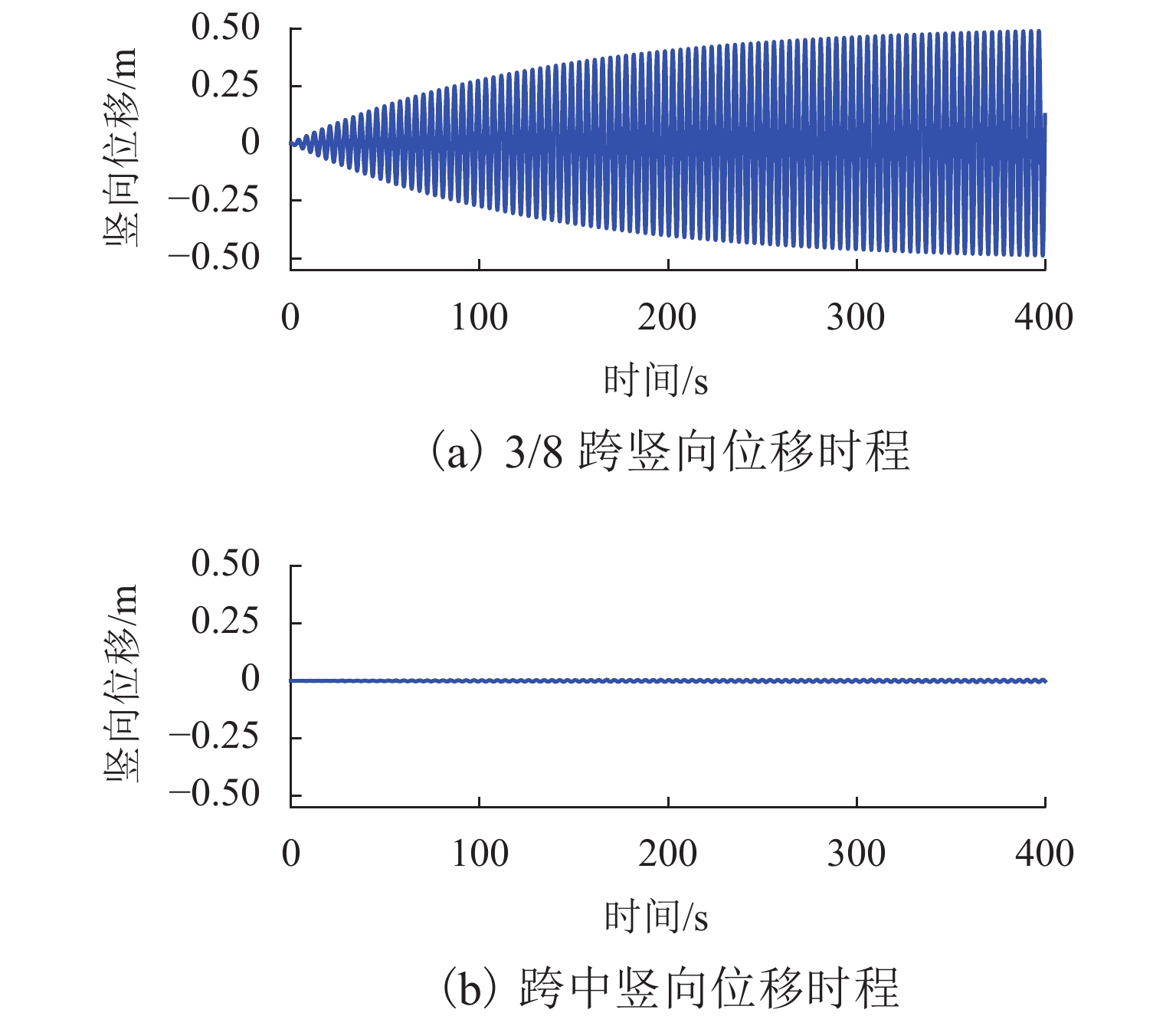

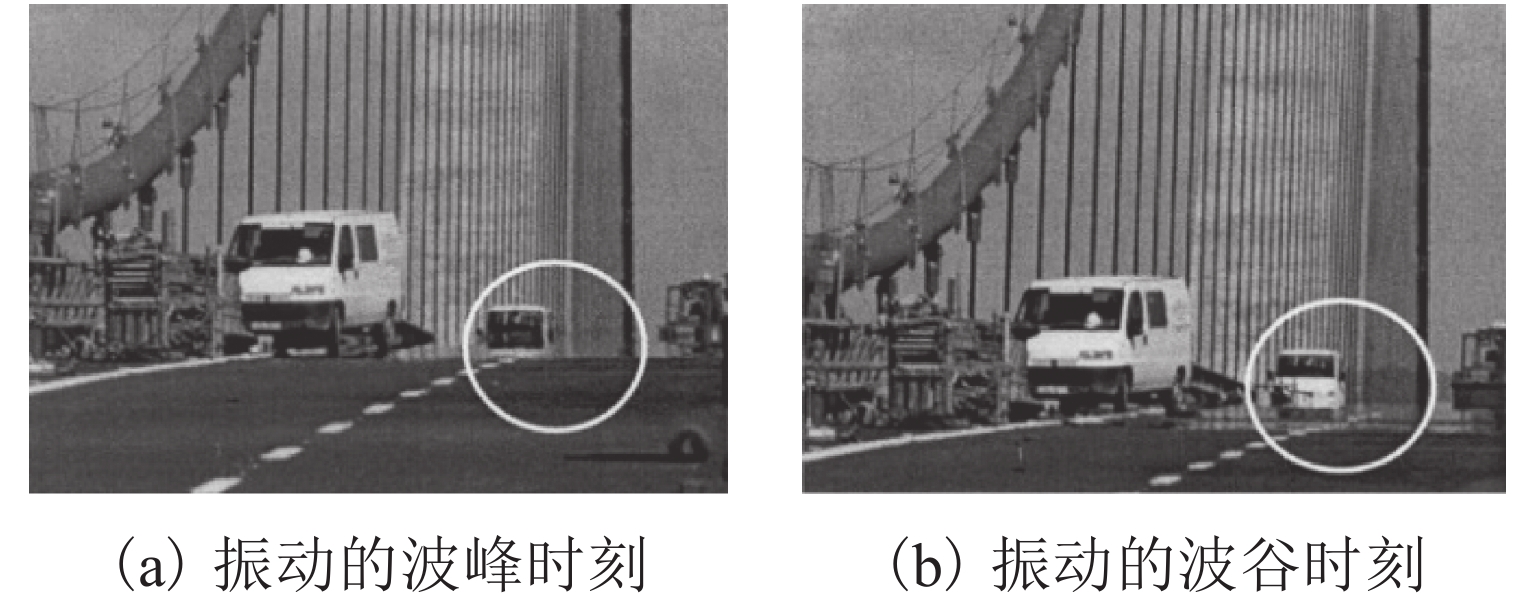
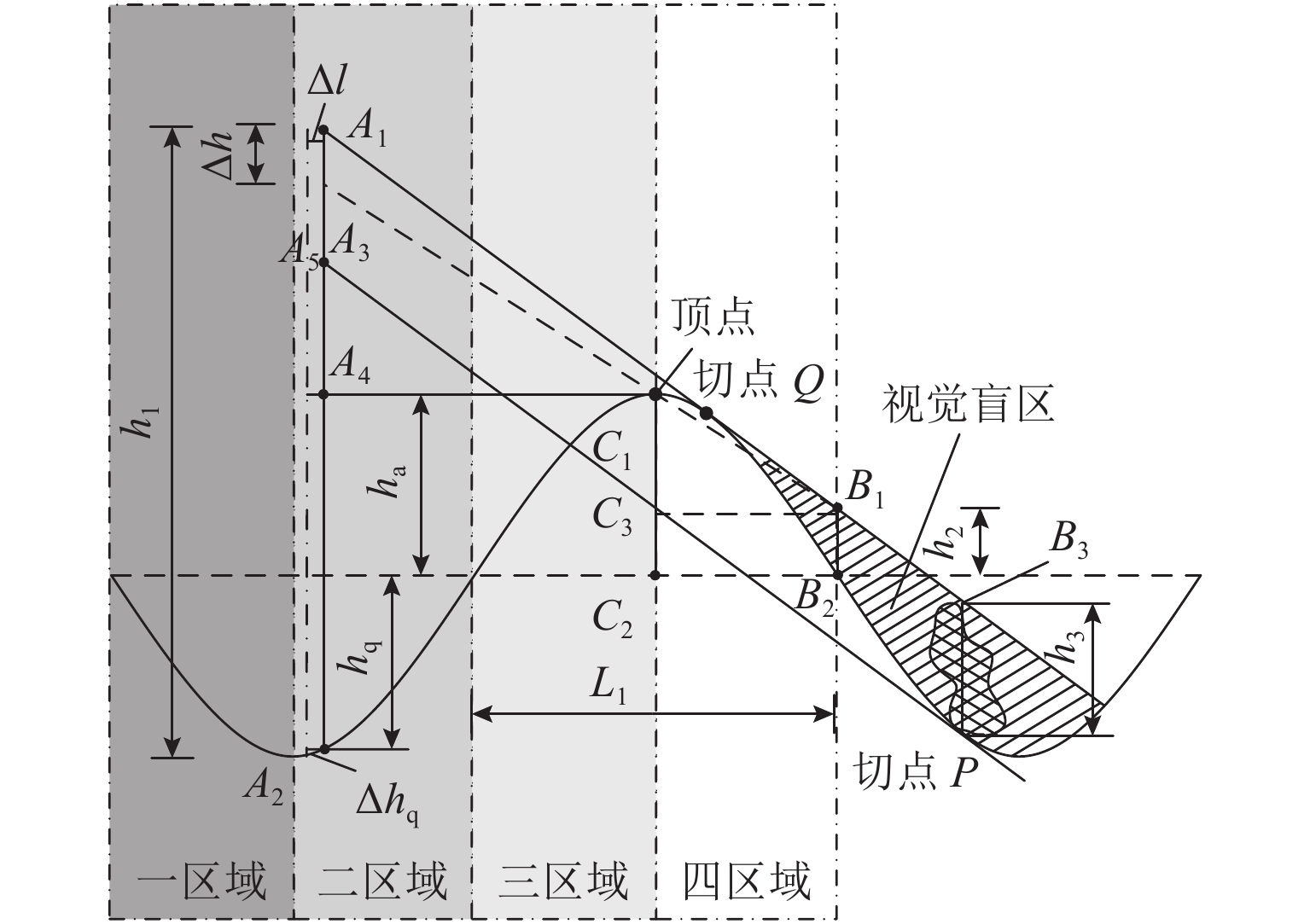
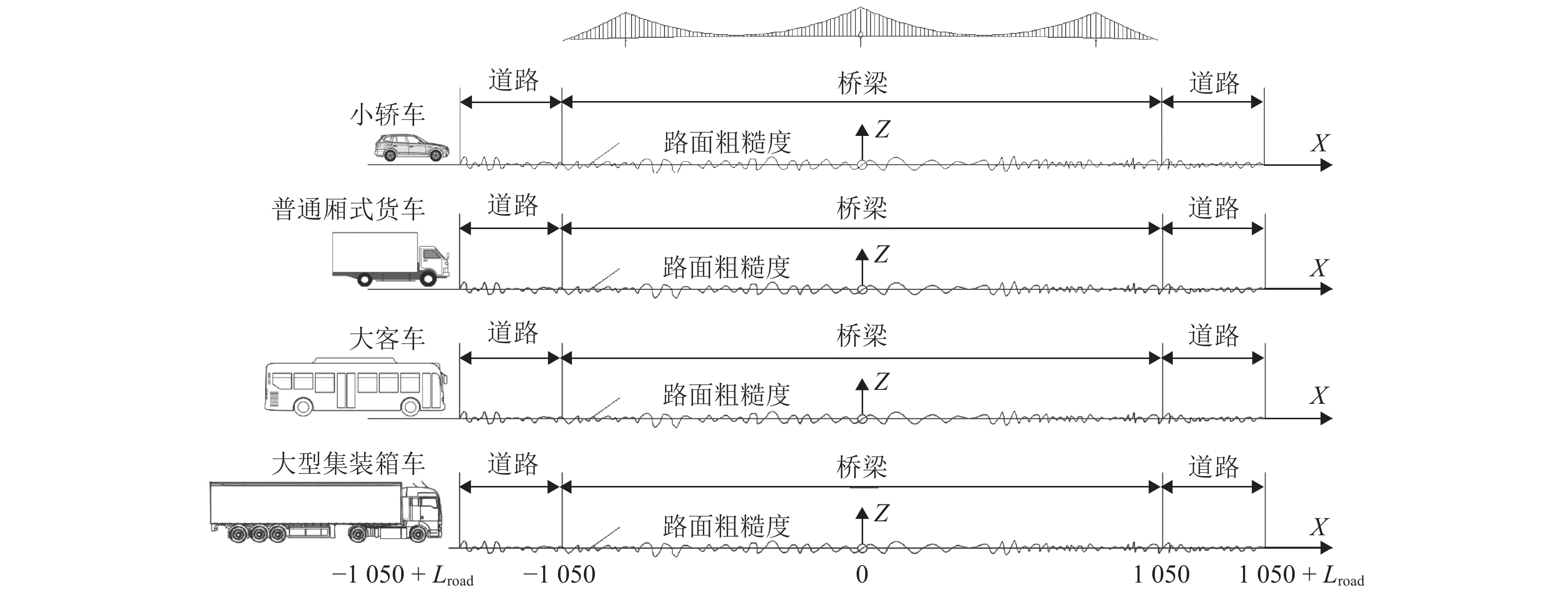
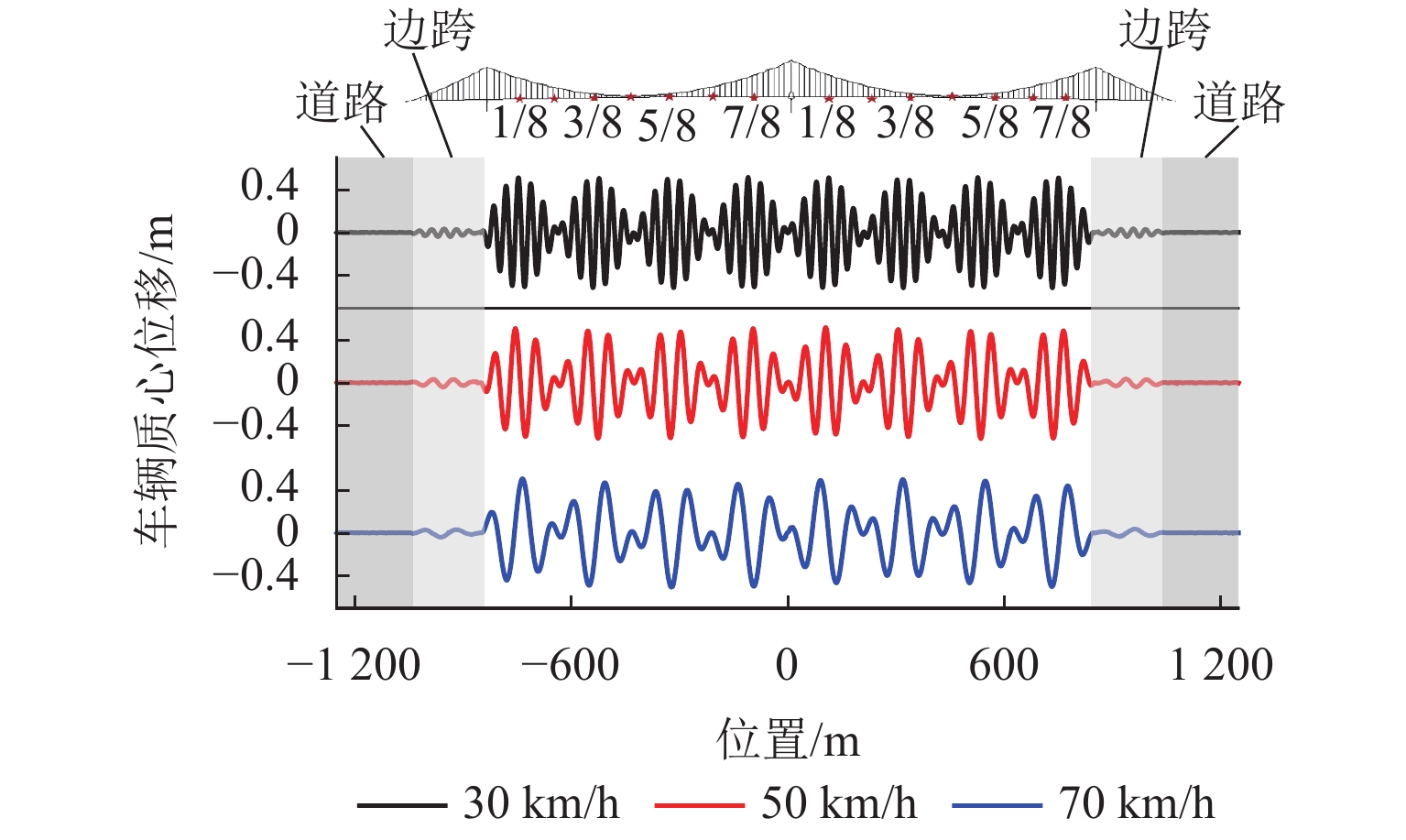
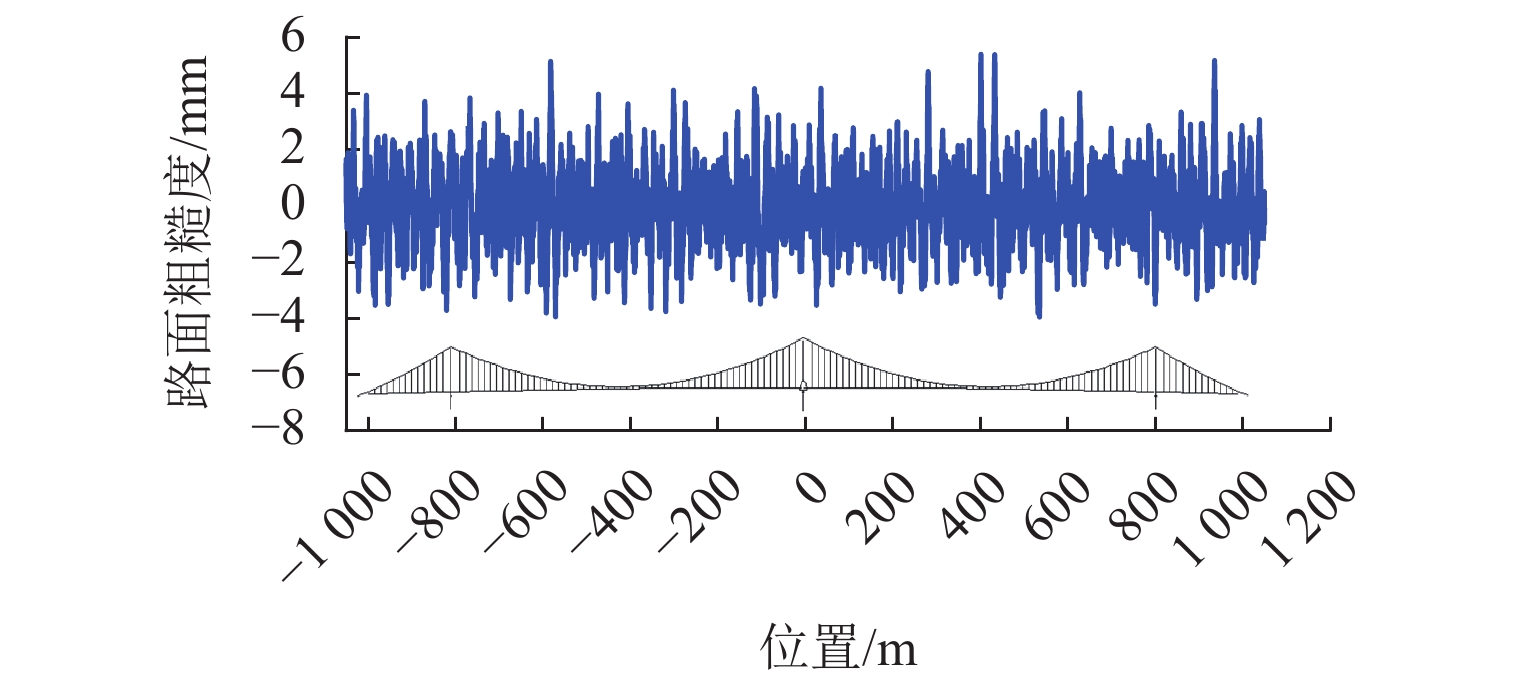
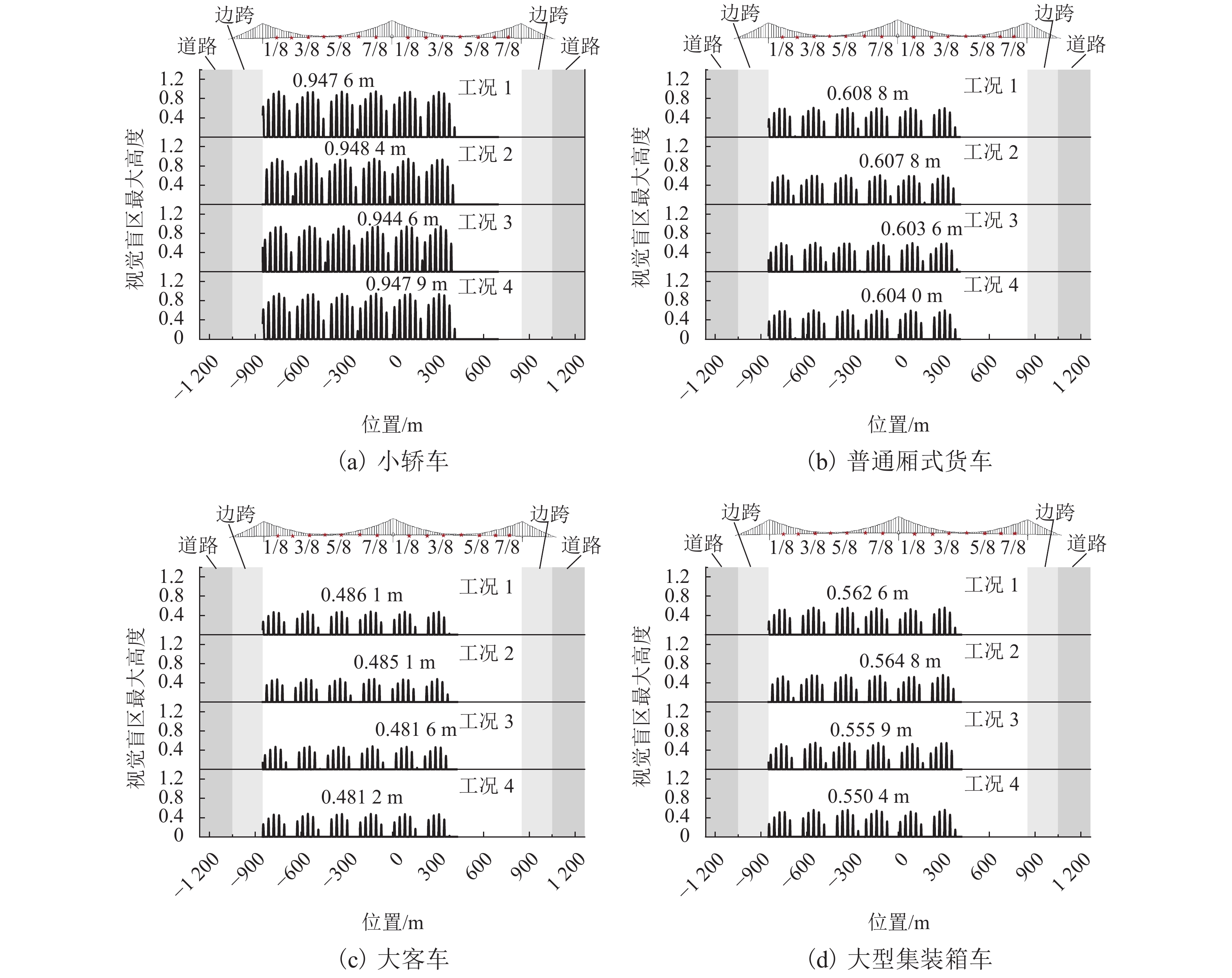
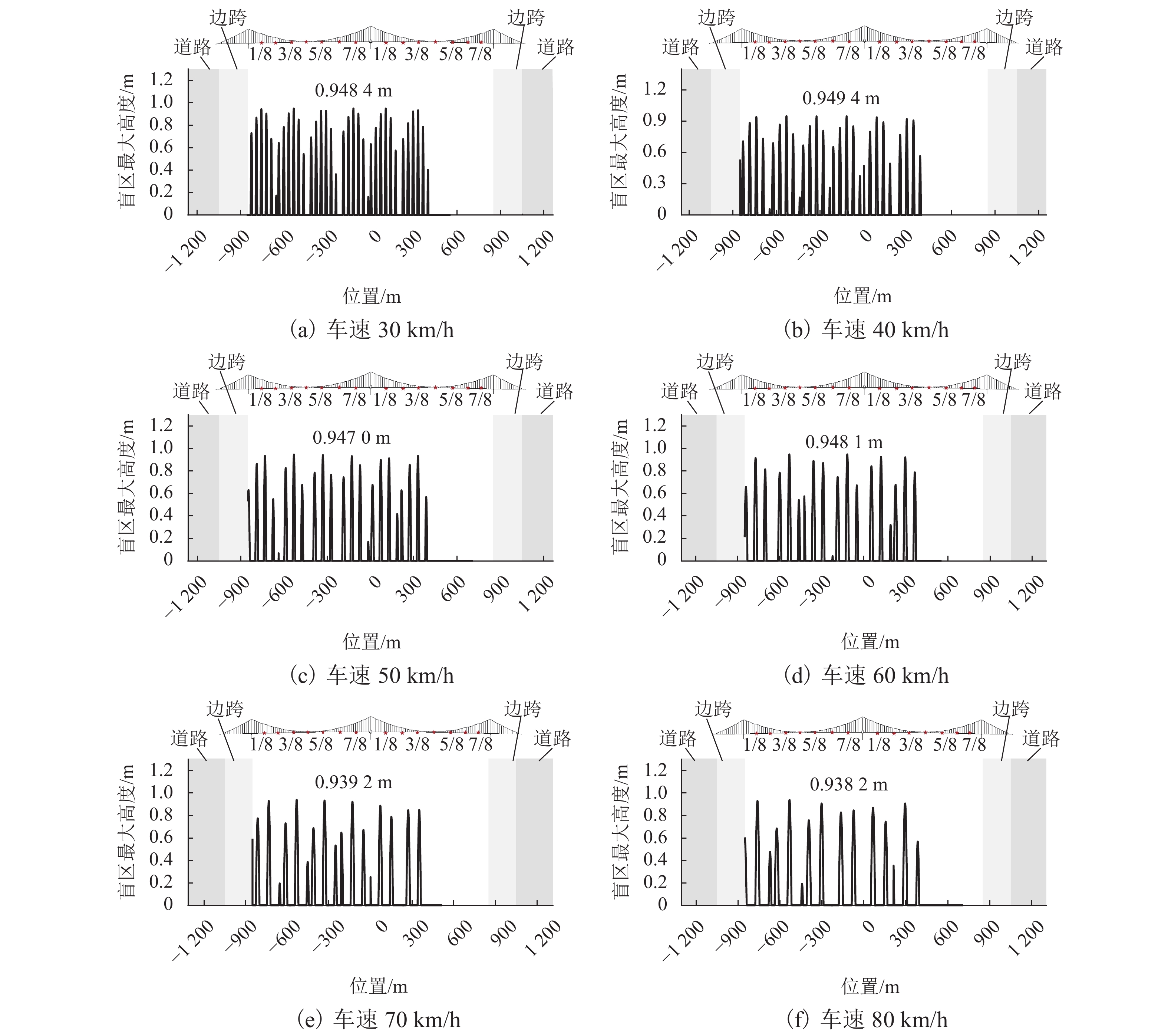
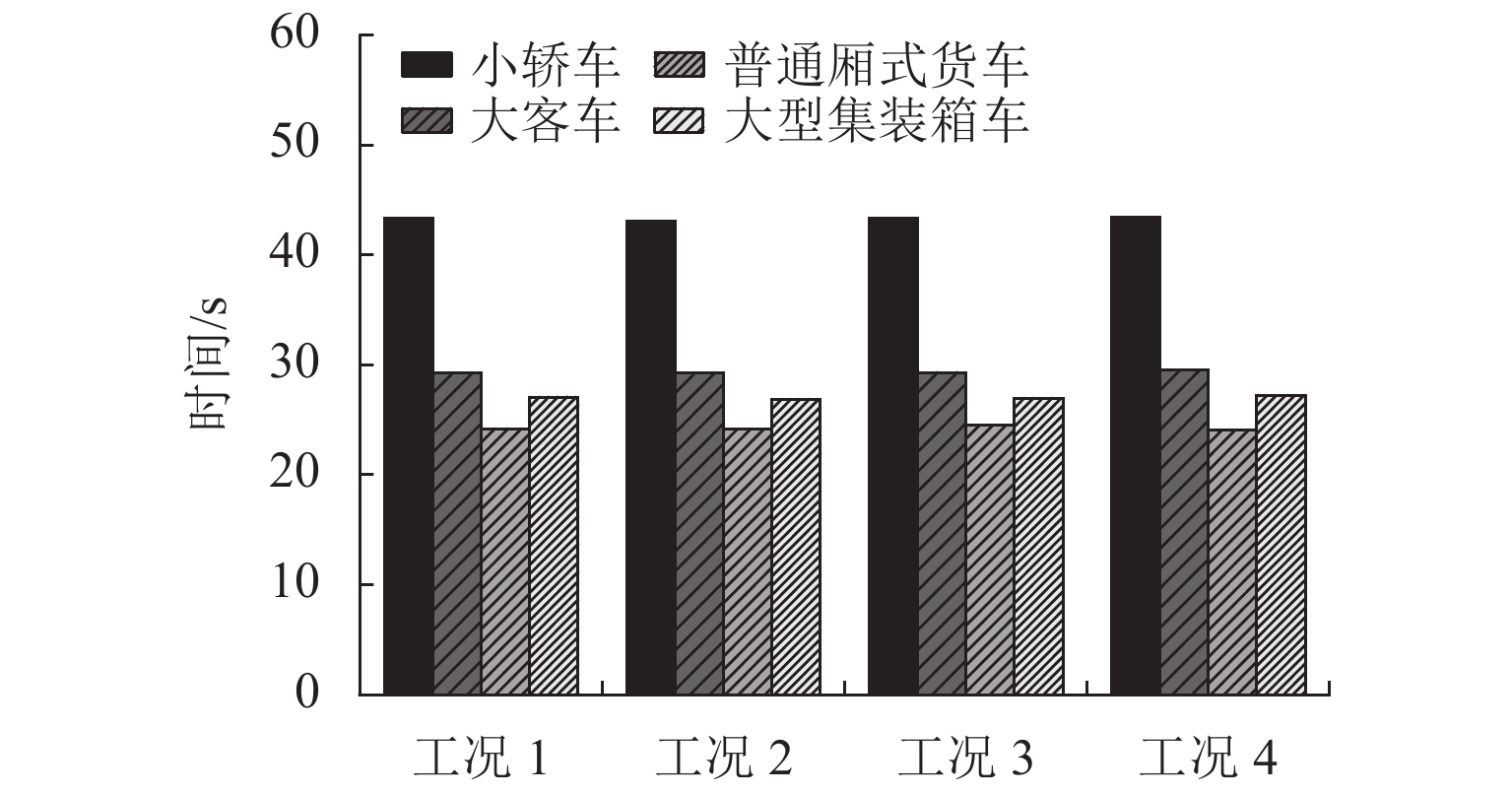
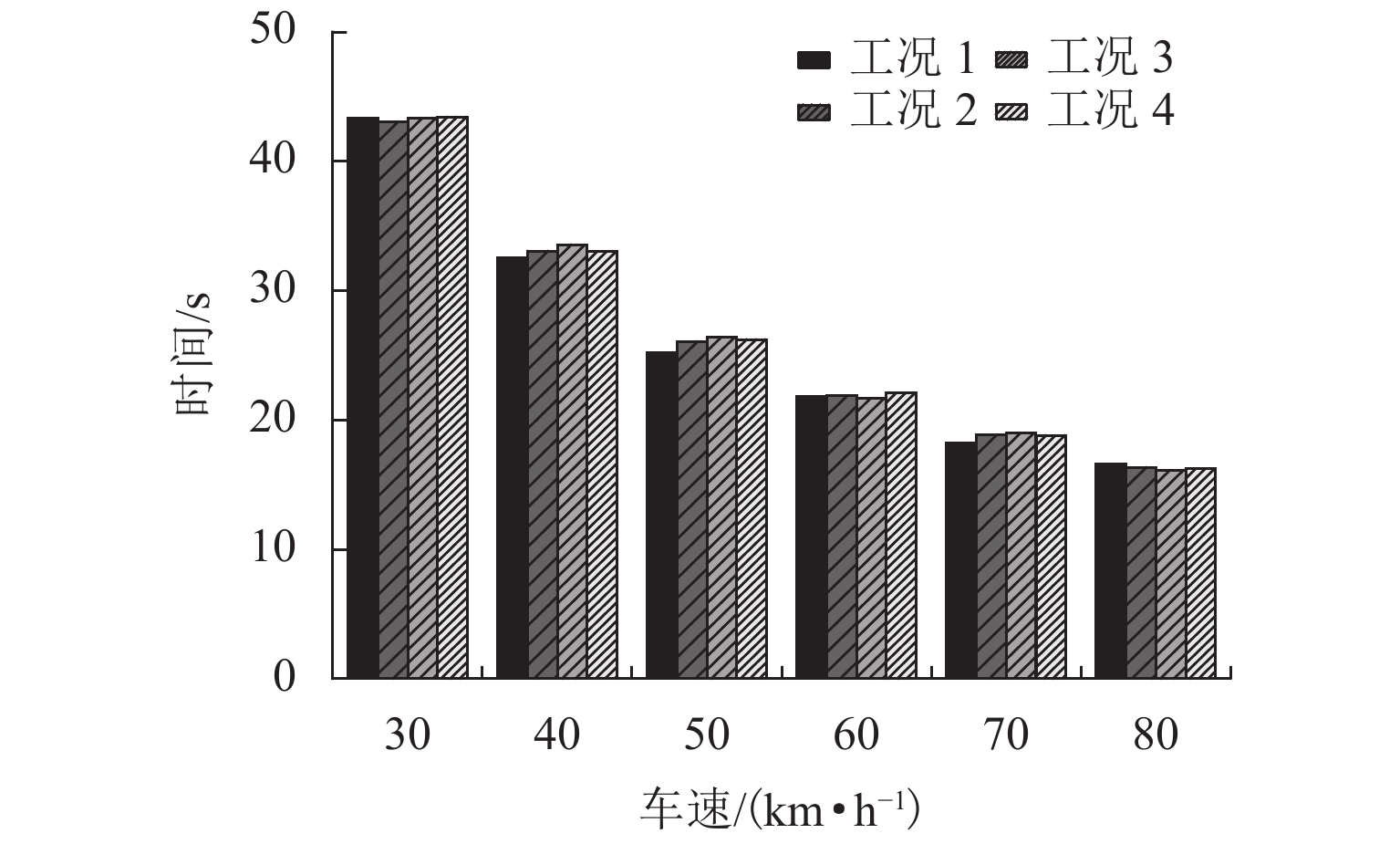
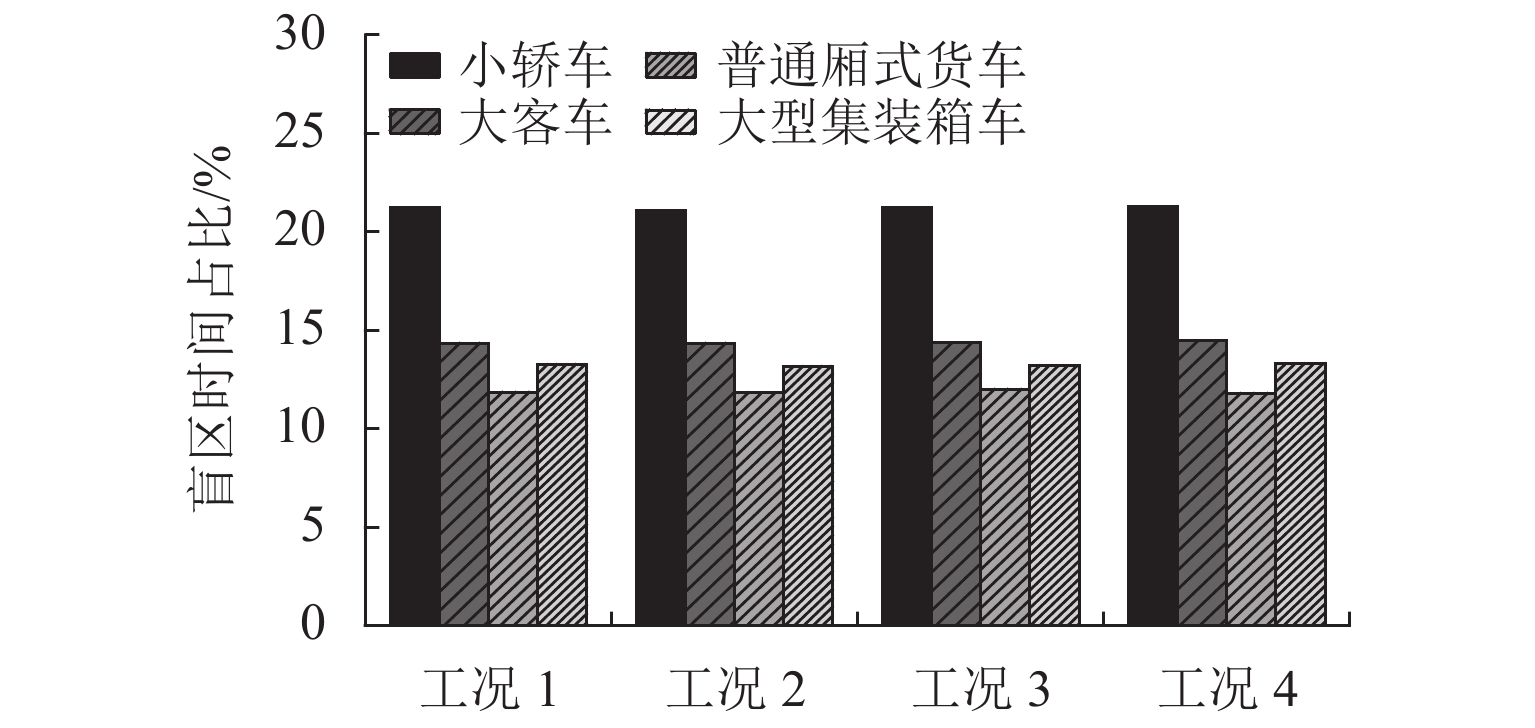
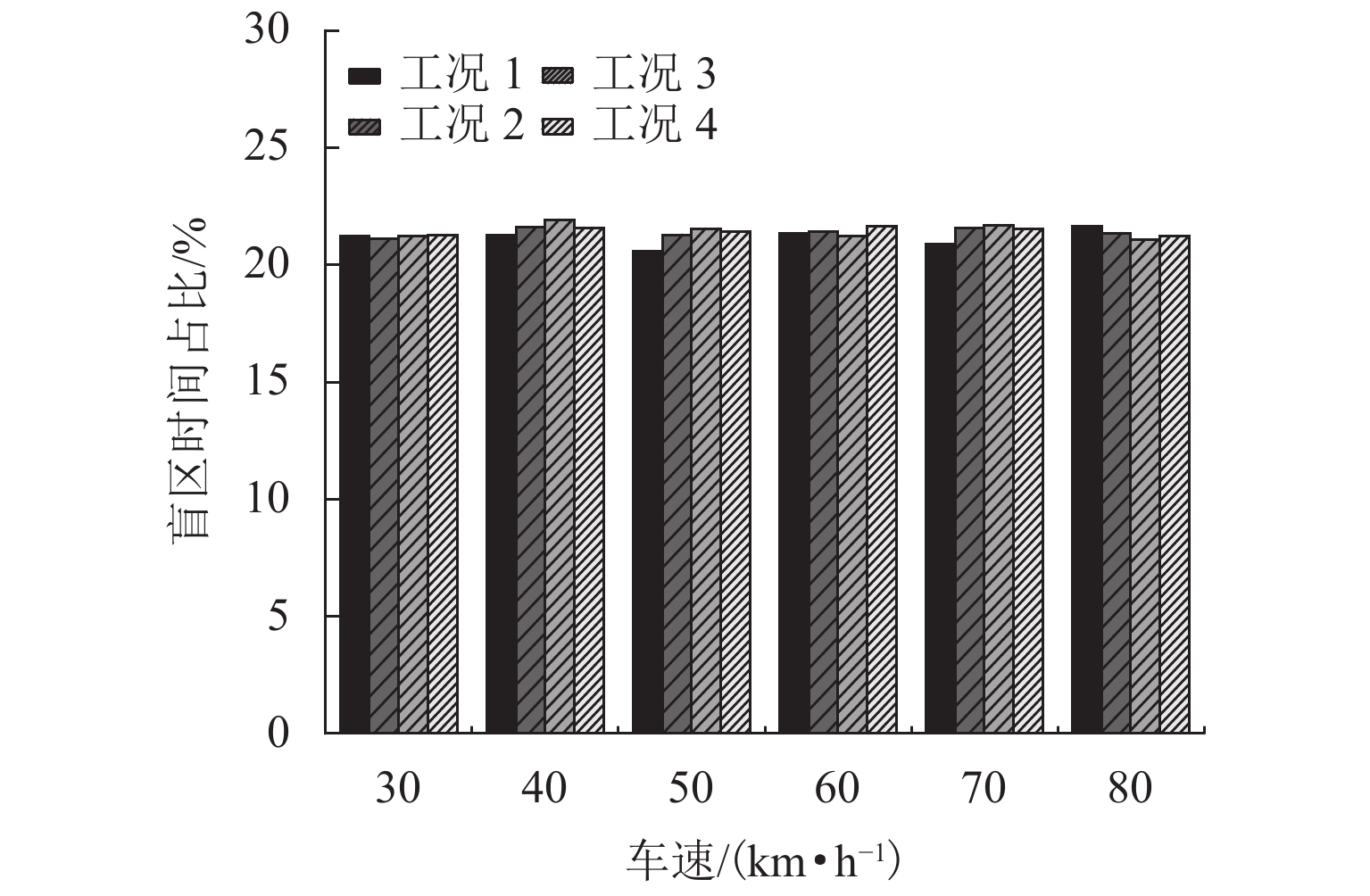
 百度学术
百度学术




